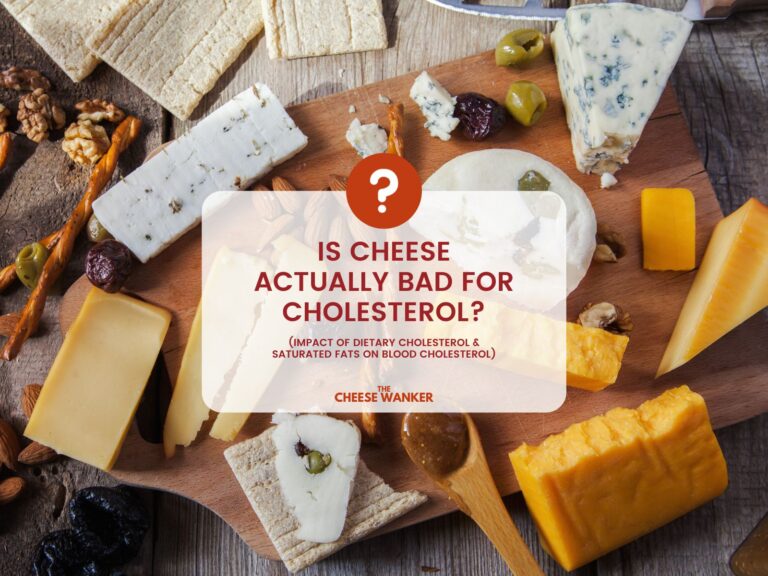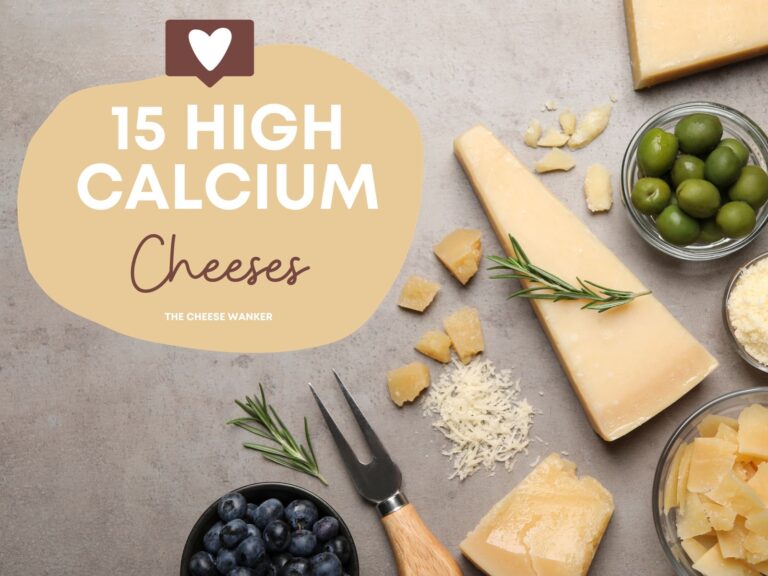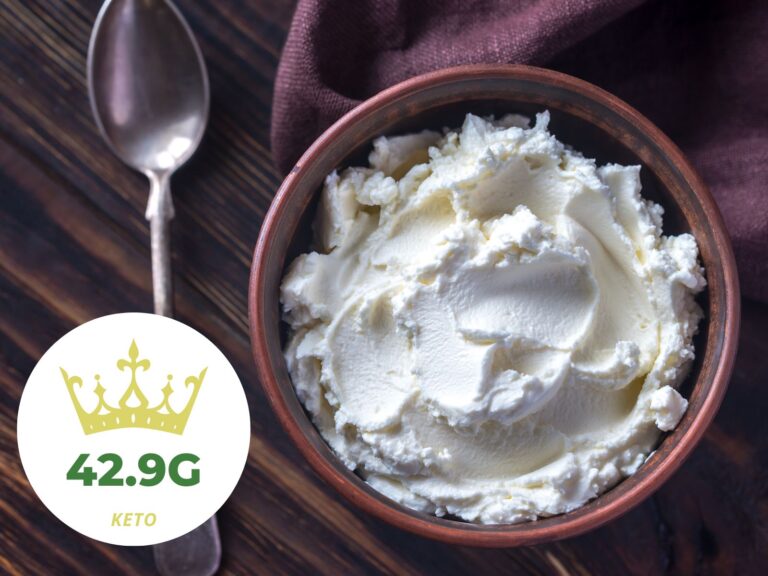Navigating dietary restrictions when dealing with gastrointestinal sensitivities like irritable bowel syndrome (IBS) can be a challenging journey. The low FODMAP diet offers relief for individuals seeking to manage their symptoms effectively. In this blog post, we delve into the scientific intricacies of this popular diet, exploring the best low FODMAP cheeses that align with its principles.
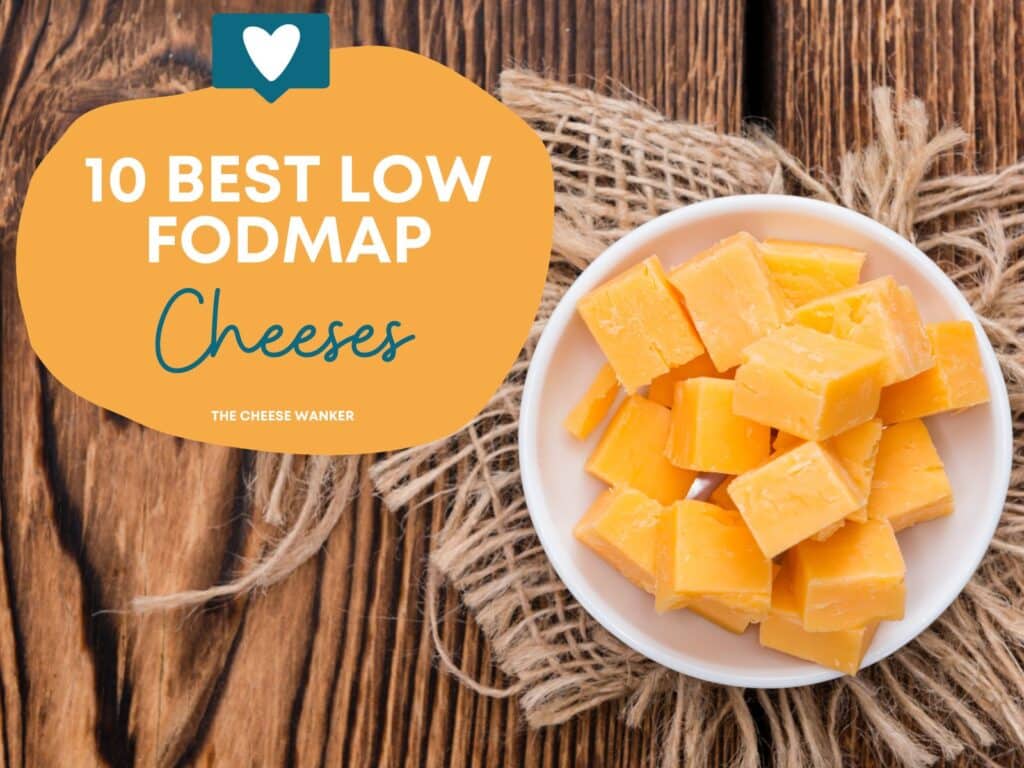
SEE ALSO: What are the healthiest types of cheeses based on nutritional profiles →
What is the low FODMAP diet?
A low FODMAP diet is a dietary approach designed to help manage symptoms of irritable bowel syndrome (IBS) and other gastrointestinal disorders. FODMAP stands for Fermentable Oligosaccharides, Disaccharides, Monosaccharides and Polyols, which are types of carbohydrates that can be poorly absorbed in the small intestine.
When these undigested carbohydrates reach the colon, they can be fermented by bacteria, leading to symptoms such as gas, bloating, abdominal pain and diarrhoea in people with sensitive digestive systems.
The low FODMAP diet involves reducing the intake of foods high in these fermentable carbohydrates to alleviate gastrointestinal symptoms.
How does a low FODMAP diet work?
During the elimination phase of the low FODMAP diet, these high-FODMAP foods are restricted. After a few weeks, specific foods are systematically reintroduced to identify which ones trigger symptoms in individual cases.
Not everyone with IBS or other digestive issues needs to follow a low FODMAP diet. And it is advisable to work with a healthcare professional to properly implement and customise this diet based on individual needs and symptoms.
Why is a low FODMAP diet not recommended long term?
A low FODMAP diet is not typically recommended as a long-term or permanent solution for several reasons:
1. Nutritional imbalance
Many high-FODMAP foods are rich in essential nutrients, such as fibre, vitamins and minerals. Restricting these foods long-term can lead to nutritional imbalances and deficiencies.
2. Impact on gut health
Furthermore, some high-FODMAP foods, like certain fruits and vegetables, are prebiotics that support the growth of beneficial gut bacteria. Avoiding these foods long-term might negatively impact the diversity and health of the gut microbiota.
3. Psychosocial impact
Also, following a highly restrictive diet long-term can have a significant impact on an individual’s social life. It may make it challenging to dine out, attend social events or share meals with family and friends. This can lead to feelings of isolation and stress.
4. Tolerance development
Over time, the gut may develop tolerance to certain FODMAPs, meaning that some individuals might be able to reintroduce small amounts of specific high-FODMAP foods without triggering symptoms. Long-term restriction may prevent the natural development of tolerance.
5. Sustainability
A low FODMAP diet can be challenging to maintain over the long term due to its complexity and the need for strict food restriction. Compliance might decline over time, leading to lapses in the diet and potential symptom recurrence.
Is lactose a FODMAP?
Yes, lactose is a type of FODMAP. Lactose is a fermentable disaccharide sugar found in milk and dairy products. For individuals with lactose intolerance or sensitivity to FODMAPs, consuming lactose-containing foods can lead to gastrointestinal symptoms such as bloating, gas and diarrhoea.
As part of a low FODMAP diet, individuals often reduce their intake of lactose-containing foods, including certain dairy products, to manage these symptoms.
What types of food are high in FODMAPs?
Foods high in FODMAPs include:
- Certain fruits (such as apples, pears and watermelon)
- Vegetables (like onions, garlic and asparagus)
- Dairy products (such as milk, yogurt and soft cheeses)
- Wheat-based products
- Sweeteners like honey and agave syrup
It’s important to note that some foods contain different types of FODMAPs, and portion sizes also matter. People following a low FODMAP diet often work with a healthcare professional or a registered dietitian who specialises in this diet.
This will help them to navigate food choices, identify trigger foods and create a personalised eating plan tailored to their specific needs.
High FODMAP cheeses
While there are cheeses that fit well within the confines of a low FODMAP diet, there are certain varieties that should be approached with caution due to their higher FODMAP content.
For individuals sensitive to these fermentable carbohydrates, it’s advisable to limit or avoid the following:
1. Fresh cheeses
Fresh cheeses like Ricotta and Cottage Cheese are higher in lactose, making them potentially troublesome for individuals with lactose intolerance. Their FODMAP content can exacerbate digestive symptoms, especially in larger quantities.
2. Soft cheeses
Soft cheeses such as Brie and Camembert contain less lactose than fresh cheeses but may still be problematic. While their creamy textures might be tempting, those following a low FODMAP diet should consume them sparingly to minimise potential discomfort.
3. Processed cheese products
Processed cheese spreads, sauces and products often contain added ingredients, including high-fructose corn syrup and other FODMAP-rich components. Checking labels for hidden FODMAPs is essential when considering these cheese options.
4. Large servings of any cheese
Even some low FODMAP cheeses can become problematic in excessive amounts. Portion control remains crucial, as overindulging in any cheese can lead to digestive distress, especially for individuals with heightened sensitivity to FODMAPs.
Understanding the FODMAP content of different cheese varieties empowers individuals to make informed choices, steering clear of options that could trigger discomfort.
What are some examples of low FODMAP cheeses?
When it comes to enjoying cheese while following a low FODMAP diet, there are several delightful options that are easy on the digestive system.
Here are ten examples of low FODMAP cheeses:
Cheddar Cheese
Cheddar cheese, renowned for its savoury and tangy flavour, is aged to perfection, resulting in a lactose-friendly delight. Its versatility makes it a staple in sandwiches, casseroles and snacks, offering a burst of tangy goodness.
Gruyère
With its nutty sweetness and smooth texture, Gruyère is a low FODMAP cheese that adds depth to salads and sandwiches. Its mild yet distinctive taste makes it a popular choice for various culinary creations.
Parmesan Cheese
Originating from Italy, Parmesan cheese boasts a granular texture and a salty, robust flavour. Aged Parmesan is effectively lactose-free, making it a great low FODMAP ingredient in pasta dishes, soups and salads.
Feta Cheese
Crumbly and tangy, Feta cheese is traditionally crafted from sheep’s and goat’s milk and contains minimal lactose. Its delightful taste enhances Mediterranean salads, wraps and appetisers.
Gouda
Dutch Gouda cheese features a sweet, nutty taste that intensifies as it ages. Its elastic texture and sweet flavour make it an ideal choice for snacking and cheese platters.
Comté
Hailing from the French Jura, Comté has a firm texture and a sweet, nutty aroma. Its versatile nature allows it to be savoured on its own or incorporated into a variety of dishes, adding depth to every bite.
Provolone Piccante
With a mild spiciness and savoury flavour, aged Provolone cheese is low in lactose. Hence, it is suitable for sandwiches and burgers, providing a delightful melt-in-your-mouth experience.
Manchego
Originating from Spain, Manchego cheese is crafted from sheep’s milk, offering a creamy texture and a nutty, savoury taste. It pairs wonderfully with fruits, crackers and charcuterie, enhancing any cheeseboard.
Blue Stilton
A classic English blue cheese, Stilton is known for its rich, strong flavour profile. While best enjoyed in moderation due to its moderate FODMAP content, it adds a bold and indulgent twist to salads, dressings and sauces.
Havarti
Finally, Danish Havarti cheese is semi-soft with a mild, buttery taste. Its excellent melting qualities make it a favourite for grilled sandwiches, burgers and hot dishes, providing a creamy and satisfying experience.
When incorporating these low FODMAP cheeses into your diet, remember that moderation is key. By savouring these options mindfully, you can relish the flavours without compromising your digestive comfort.
You can explore our comprehensive database of lactose content in cheese by clicking here.
Low FODMAP recipes using cheese
Embarking on a low FODMAP diet doesn’t mean sacrificing flavour and enjoyment in your meals. In fact, with a bit of creativity and the right ingredients, you can create delicious and satisfying dishes that are gentle on your digestive system.
In this section, we’ve curated a selection of mouthwatering recipes featuring cheese, carefully crafted to adhere to low FODMAP guidelines.
Gouda and Spinach Omelette

Start your day with a nutritious and flavourful Gouda and Spinach Omelette. Whisk together eggs and a splash of lactose-free milk in a bowl. In a non-stick skillet, sauté fresh spinach until wilted, then pour the egg mixture over the spinach.
Add slices of aged Gouda cheese on one half of the omelette and fold the other half over the cheese. Cook until the eggs are set and the cheese is melted. This omelette is a protein-packed breakfast option that combines the earthy taste of spinach with the sweetness of Gouda.
Havarti and Chive Mashed Potatoes
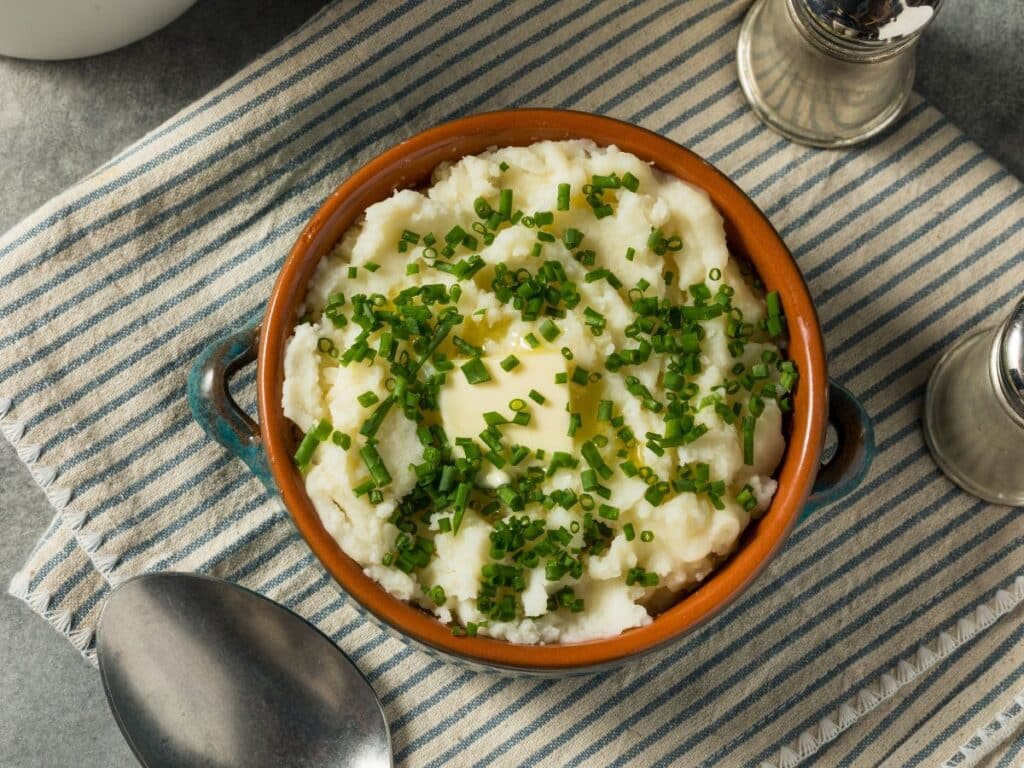
Upgrade your classic mashed potatoes with Havarti and Chive Mashed Potatoes. Boil peeled and diced potatoes until tender, then mash them with lactose-free butter and lactose-free milk until creamy.
Fold in grated Havarti cheese and finely chopped fresh chives. Season with salt and pepper to taste. These indulgent mashed potatoes are rich and creamy, with the subtle sweetness of Havarti and the freshness of chives, making them a delectable side dish for any meal.
Feta and Zucchini Fritters
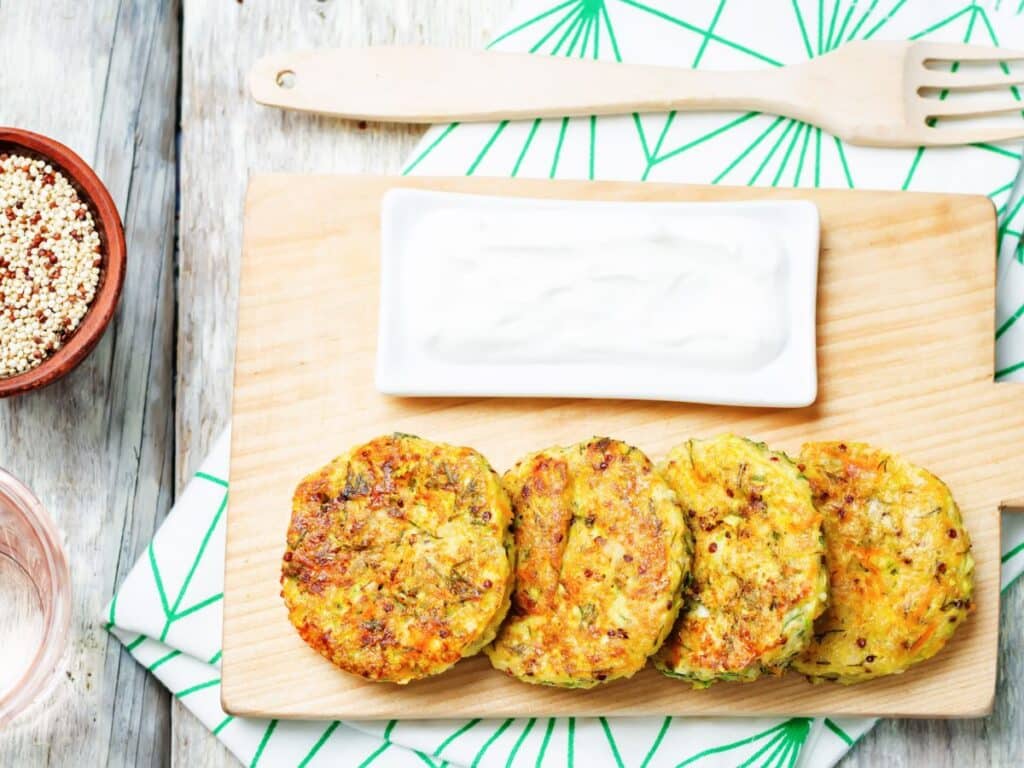
Prepare flavourful Feta and Zucchini Fritters that are crispy on the outside and tender on the inside. Grate zucchini and squeeze out excess moisture. In a bowl, mix the grated zucchini with crumbled Feta, chopped fresh dill, quinoa and breadcrumbs.
Form the mixture into patties and pan-fry until golden brown. These fritters are a delightful appetiser or light meal, combining the saltiness of Feta with the mild sweetness of zucchini.
Conclusion
When following a low FODMAP diet, navigating cheese selections might initially seem daunting. However, armed with knowledge about lactose content and the ageing process, you can enjoy a variety of cheeses without compromising your digestive comfort.
From the delightful tang of Cheddar to the nutty sweetness of Comté, there’s a wide array of low FODMAP cheeses to satisfy your culinary cravings.
Remember, moderation and portion control are key. By savouring these cheeses in appropriate quantities and incorporating them into well-balanced, low FODMAP recipes, you can relish the pleasures of the palate without triggering unwanted gastrointestinal symptoms.
Are you currently on a low FODMAP diet? We’d love to hear about your experiences. Leave us a comment below.
